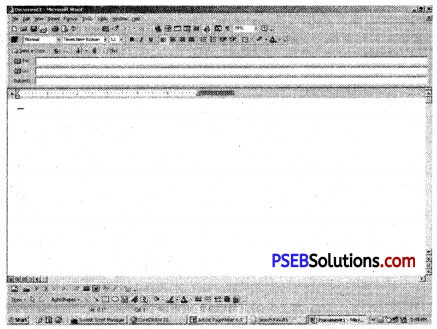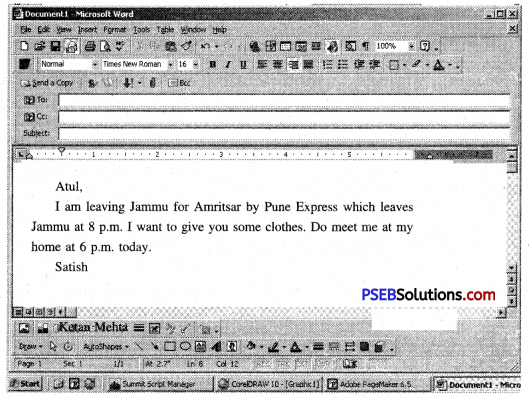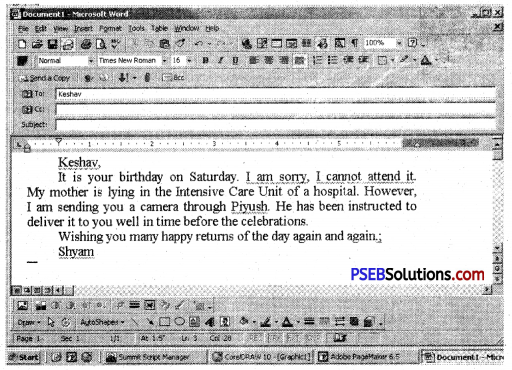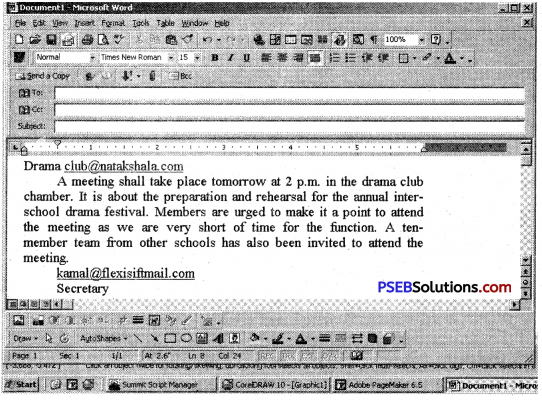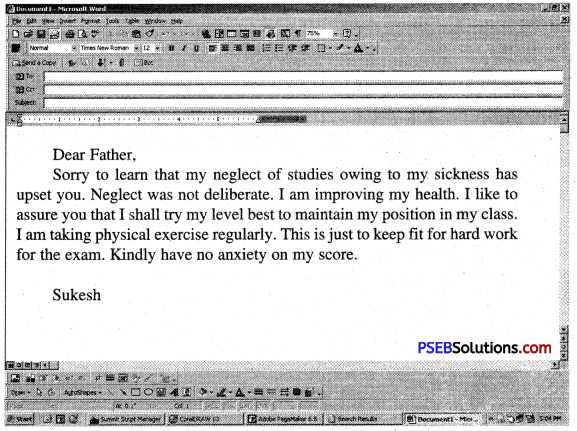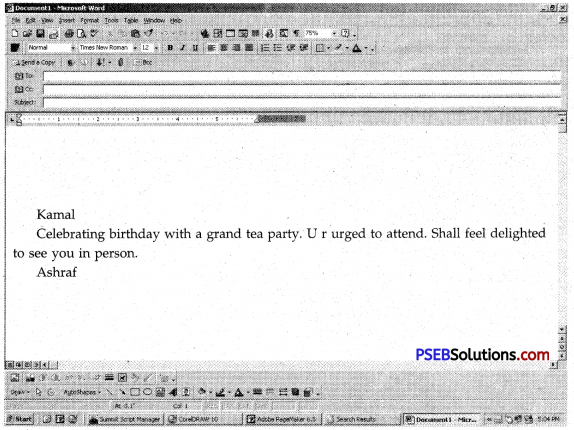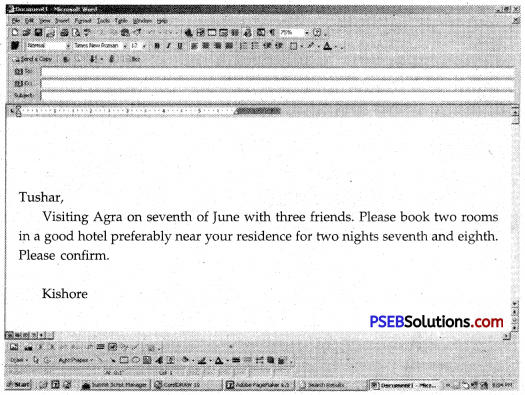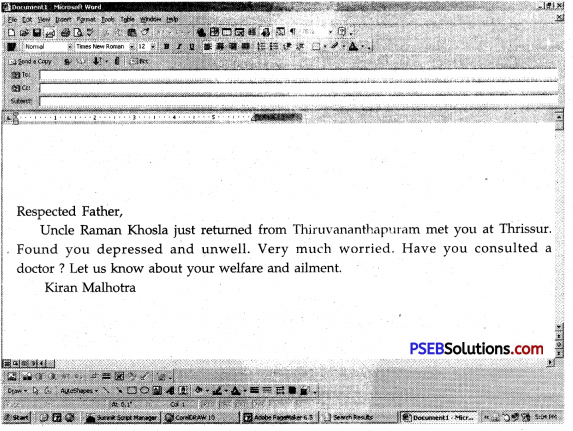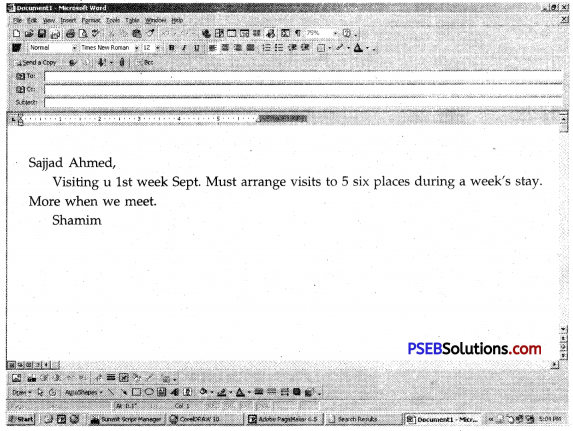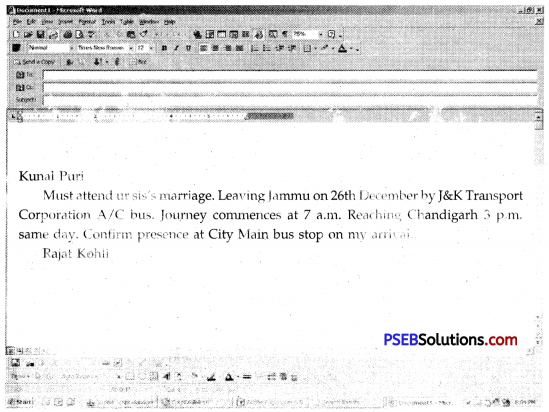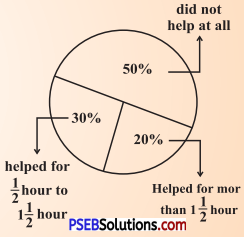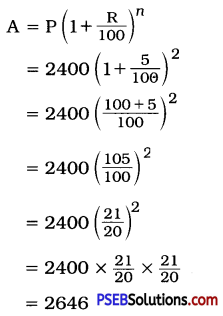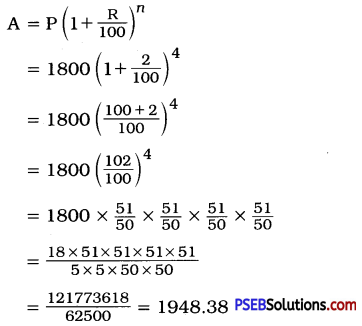Punjab State Board PSEB 12th Class English Book Solutions English Letter Writing Business Letters Exercise Questions and Answers, Notes.
PSEB 12th Class English Letter Writing Business Letters
1. Applications for Different Jobs
1. Write an application for the post of a Steno-typist.
14, Civil Lines,
Amritsar.
August 6, 20 ………….
The Advertiser,
Post Box No. 313,
The Tribune,
Chandigarh.
Sir,
This is in response to your advertisement in ‘The Tribune’ dated 4th August 20 for the post of a Steno-typist in your office. I beg to offer myself as a candidate for the same. As regards my qualifications, they are detailed below:
I passed my BA. Examination in 20 ………. from D.A.V. College, Amritsar. I was placed in the second division. After my graduation, I joined a commercial college where I learnt both short-hand and type-writing. My speed in short-hand is 75 w.p.m. and my speed in type-writing is 50 w.p.m. I have been working as a steno-typist with Sehgal & Co., Amritsar for the last five years. Besides short-hand and type-writing, I am also well conversant with other official work and can speak fluently English, Hindi and Punjabi.
I am still in the service of the same firm. I am seeking better opportunities which my present employer, with his limited business, cannot supply. He has no objection to my seeking a better job somewhere else.
I am a youngman of 25 with a sound physique and an impressive personality.
I enclose a certificate from my present employer in regard to my character, experience and ability. Should you appoint me to the post, it would be my sincerest effort to give you every satisfaction.
Yours faithfully,
H.M.L. Sood

2. Reply to above.
Messrs Datta & Co.,
130, Park Lane,
New Delhi-15.
August 11, 20……
Mr. H.M.L. Sood,
14 Civil Lines,
Amritsar.
Dear Sir,
We have your application of the 6th August, for the post of a steno-typist in our office. We are glad to inform you that we have decided to appoint you for the post.
Your appointment will be on a temporary basis for three months. If your work and conduct are found satisfactory, you will be made permanent. Your salary will be Rs 12000/- per month during the temporary period and Rs 12450/- per month with a yearly increment of Rs 450/- on your being made permanent. Your promotion depends entirely on your hard work, honesty and sincerity.
If the appointment is acceptable to you, please let us know by return of post the date when you can join.
Yours faithfully,
R.M. Sinha,
Manager
3. Write an application for the job of an Asstt. Manager in a large firm – Messrs Ghooki and Sons – selling electrical appliances. Give details of your qualifications and experience and mention the minimum salary acceptable to you.
510, Church Street,
Chandigarh.
July, 28, 20……….
Messrs Ghooki and Sons,
R-120, Connaught Place,
New Delhi-1.
Dear Sirs,
In response to your advertisement in ‘The Times of India’ dated July 26, 20…. for the post of an Asstt. Manager in your firm engaged in selling electrical appliances, I beg to offer my services for the same. As desired by you, I give below a few particulars about myself.
I passed my M.A. (Economics) from St. Stephen’s College, New Delhi in 20… After my Post-Graduation, I passed M.B.A. course in 20…. from Punjab University, Chandigarh. I was placed in the first division. Since then I have been working in Mumbai Electricals in the capacity of an Asstt. Manager. I am 30 years of age. I have an experience of six years. I can plan and execute sales independently. I have an unblemished record and my present employer wants me to stay on. But I wish to come to my home town that is, Delhi.
At present I am drawing ? 25000/- p.m. and have a free furnished accommodation. I can join your concern at a minimum salary of ^ 35500/- plus a free furnished accommodation and a car at the company’s expense.
I am prepared to attend an interview only at your expense. Copies of my certificates and testimonials are enclosed herewith for your kind perusal.
Yours faithfully,
Shankar Chauhan
4. Reply to Application No. 3.
Messrs Ghooki & Sons,
R-120, Connaught Place,
New Delhi-I.
July 31, 20 ………..
Sh. Shankar Chauhan,
510, Church Street,
Chandigarh.
Dear Sir,
In reply to your application dated 28th July, for the post of an Asstt. Manager, we are glad to inform you that we are ready to offer you the job at the salary demanded by you. We shall also give you free furnished accommodation and a car at company’s expense. However, you will have to sign a contract to serve in our firm for a minimum period of 4 years.
If the above terms are acceptable to you, kindly make it convenient to call at our office on 10th August, 20 ………… at 10 A.M. to settle other details of your appointment.
Yours faithfully,
R.P. Ghooki,
Managing Director
5. Write an application for the post of a P.A. to the Technical Manager of Calico Textiles. The post requires knowledge of short-hand typing and textiles of all varieties. Quote references.
14, Patel Road,
New Delhi-33.
May 26, 20 ……….
The Technical Manager,
Calico Textiles,
Amritsar.
Dear Sir,
In response to your advertisement in ‘The Times of India dated May 22, 20…. for the post of a P.A., I beg to offer myself as a candidate for the same.
I passed my Higher Secondary Examination in the first division. I passed B. Com. Final in 20 with Hons, in Secretarial Practice. I was immediately employed by Mohindra Textiles, New Delhi and have been working there to the satisfaction of my superiors. I am seeking better opportunities which my present employers with their limited range of business cannot supply. They have no objection to my seeking a better job somewhere.
I am a young man of 26 with a pleasing personality. I am capable of doing hard work. I enclose a certificate from my present employers in regard to my character, experience and ability.
Should you appoint me to the post, it would be my sincerest effort to give you every satisfaction. Once again I assure you that I will do my duty honestly and conscientiously.
Yours faithfully,
Sunil Sharma
6. Reply to above.
The Technical Manager,
Calico Textiles,
Amritsar.
May 30, 20 …….
Mr. Sunil Sharma,
14, Patel Road,
New Delhi-33.
Dear Sir,
In reply to your application for the post of a P.A. dated May 26, 20 …………. I should be glad if you call at my office on Monday morning next so that I may discuss details concerning the post for which you have applied.
The initial salary offered is Rs 12400/- per month, the engagement being terminable at one month’s notice on either side.
Yours faithfully,
S.M. Kakkar
2. Placing Orders
7. Placing Order for Steel Furniture.
Messrs Raja Sodhi &C Co.,
(Steel Furniture Dealers)
Prasad Road,
Ludhiana.
October 3, 20 ……….
Ref. No. 602/…. RS
The Manager,
Messrs Mahesh & Co.,
Rani Jhansi Road,
New Delhi-11.
Dear Sir,
We are in receipt of your quotation October, 1, 20… and thank you for the same. Please arrange to supply us the following goods as early as possible:
12 Nos…. Steel Almirah, size 84⊄⊄ at Rs 700 Per Piece.
12 Nos…. Manager’s Table, size 60⊄⊄ at Rs 400 Per Piece.
Sales and any other tax, if required, will be paid extra.
As desired by you, we are enclosing herewith our cheque No. STB/610073 dated October 3, 20….. for Rs 10,000/- only as advance and balance will be paid as soon as the goods are delivered.
In this connection, please note that if you make your terms liberal, we confirm, we shall be able to give you a good turnover per year. Please see what you can do.
Thanking you,
Yours faithfully,
Ram Chand
Manager
Enel. : One cheque.
No. : STB/610073.
Date : October 3, 20 …..
Amount : Rs 10,000/- only.
Back : State Bank of India, New Delhi-1.

8. Reply to above.
Messrs Mahesh & Co.,
Rani Jhansi Road,
New Delhi-11.
October 10, 20 …….
The Manager,
Messrs Raja Sodhi & Co.
(Steel Furniture Dealers)
Prasad Road,
Ludhiana.
Dear Sir,
We thank you for your order of the 3rd October, 20… and are pleased to state that the goods required have been despatched by passenger train this morning.
We trust that the goods will arrive in excellent condition and their quality will induce your good self to send further orders.
Yours faithfully,
K. Mahesh,
Manager
Enel. : Invoice
R/R No. : Nd/16003
Dated : October 10, 20….
9. Placing Order for Books.
R. Chand & Co.,
(Booksellers)
College Road,
Patiala.
July 18, 20 ……..
Messrs Malhotra Publishers,
Railway Road,
Jalandhar City.
Dear Sirs,
We are in receipt of your letter No. B-605/78 K dated 8th July, 20 alongwith a list of your publications. We thank you for the same.
Please supply us immediately:
40 Copies AS YOU LIKE IT by Prof. Ashok @ Rs 19/- each.
40 Copies MBD English Guide, TDC, III @ Rs 45/- each.
30 Copies MBD Economics Refresher B.Com. II, @ Rs 26/- each.
40 Copies MBD History Refresher TDC 11 @ Rs 12/- each 25 Copies
MBD Refresher English Guide, B.Com. 1, @ Rs 16/- each.
As desired by you, we are enclosing herewith our cheque No. SKB/K 10032 dated July 18, 20…… for Rs 1500/- only as advance and the balance will be paid against delivery.
Our next order will be forwarded as and when necessary.
Yours faithfully,
Ravinder Ghai,
Proprietor
Enel. : One cheque.
No. : SKB/K10032.
Date : July 18, 20 …….
Amount : Rs 1500/-
Bank : State Bank of India,
Patiala.
10. Acknowledging a Big Order.
Messrs Malhotra Publishers,
Railway Road,
Jalandhar City.
July 12, 20……
Ref. : MBD/MA-16 TR.
Messrs Bose & Co.,
University Road,
New Delhi-16.
Dear Sirs,
We thank you for your order No. 818. dated July 6, 20 ….. for 300 copies of MBD ENGLISH LITERATURE SERIES, “AS YOU LIKE IT” by Prof. Ashok @ Rs 90/- each copy. The order has been booked for execution and the books will be despatched by goods train on 14th July.
This is the first occasion we have the pleasure to execute your order. We heartily welcome you to our list of will-wishers and patrons. We assure you that you will always find our books satisfactory and hope this order will lead to an enduring connection with you.
Yours faithfully,
Balwant Sharma
Manager
11. Placing Order for Sports Goods.
“SPORTS CORNER”
14, Lodhi Market,
New Delhi-21.
July 6, 20 ……
Ref. No. Sc/506.
Messrs Kohli & Co.,
Sports Goods Manufacturers,
Industrial Estate,
Jalandhar City.
Dear Sirs,
I am in receipt of your quotation dated July 2, 20 …… and thank you for the same. Please supply us immediately the following items:
6 dozen Cricket balls @ Rs 120/- per dozen.
20 Cricket Bats (Durrani) @ Rs 75/- per bat.
50 pairs of Batting Gloves @ Rs 10/- per pair,
8 dozen Hockey balls (Ashok) @ Rs 100/- per dozen.
5 dozen Hockey Sticks (Champion) @ Rs 400/- per dozen.
Sales and any other tax, if leviable, will be paid extra.
As desired by you. I am enclosing herewith my cheque No. PB/c 70078 dated July 6, 20… for Rs 2,500/- only as advance and balance will be paid against delivery.
Thanking you,
Yours faithfully,
J.L. Mehta
Manager
Enel. : One cheque.
No. : PB/c 70078
Date : July 6, 20…
Amount : Rs 2,500/- only.
Bank : Punjab National Bank, New Delhi-1.
12. Reply to Letter No. 11.
Messrs Kohli & Co.,
Sports Goods Manufacturers,
Industrial Estate,
Jalandhar City.
July 9, 20 …….
The Manager,
“Sports Corner”,
14, Lodhi Market,
New Delhi-21.
Dear Sirs,
We are indebted to you for your order of the 6th July, 20 ……. and pleased to state that the goods required have been despatched by passenger train this morning.
We trust that the goods will arrive in excellent condition and their quality will induce you to send further orders.
Yours faithfully,
Satish Kohli
Sales Manager
Enel. : Invoice
R/R No. : JK/622532
Date : July 2, 20 ……..

13. Placing order for Servicing of Typewriting Machines.
Michael Limited,
(Commission Agents & Gen. Order Suppliers)
150, Park Road,
Kolkata-500025.
August 12, 20 ………
Ref. No. 1832/ML-630
Messrs Baliram & Co.
18, Church Lane,
New Delhi-32.
Dear Sirs,
Thank you for your quotation dated August 8, 20… for servicing of our different Typewriting Machines.
We do hereby accept your quotation under reference and request you to start work from the next week.
Regarding payment, though you did not mention anything in your quotation, we propose to make payments bi-monthly (i.e. 6 times in a year). Hence you are to submit your bill after completion of servicing of every two months.
Thanking you,
Yours faithfully,
R.S. Singh Purchase
Manager
14. Asking for details of Order.
Renu Hosiery Goods,
Industrial Estate,
Jalandhar City.
October 6, 20 …….
Messrs Dimple Readymade Garments,
106, Main Market,
New Delhi-13.
Dear Sirs,
We thank you for your Order No. 512 October 4, 20… for 5 dozen All-wool Pullovers, Catalogue No. 12 A, @ Rs 80/- each. We should like to inform you that you did not write the specifications in regard to size and colour. Surely, you would like to make your own choice and do not want us to send you size and colour of our selection.
We shall be glad if you kindly let us know your choice.
Yours faithfully,
V.K. Nanda
Sales Manager
3. Complaints And Adjustments
15. Complaint for Non-execution of an Order.
Upkar Traders,
6-Gurudwara Road,
Amritsar.
December 10, 20 …….
Ref. No. UT/103/………
Messrs Aggarwal & Sons,
15/162-E, Rampur Road,
Agra.
Dear Sirs,
Please refer to our order No. UT/503/ ………. dated November 2, 20 ……… for 200 Tins of Ghee (Lotus Brand).
We note with regret that the goods ordered were not delivered till this day, in spite of the fact that a prompt delivery was guaranteed and the order obtained on the strength of guarantee. The reasons are, however, beyond our knowledge.
This is not the first time a delay in delivery has occurred. Any way, we shall like to point out that business on these conditions can’t be continued for long.
We hope that this letter will cause you to settle the problem finally. Your immediate reply is expected.
Thanking you,
Yours faithfully,
Rajinder K. Singh
Purchase Officer
16. A Negative Reply to Letter No. 15.
Messrs Aggarwal & Sons,
15/162-E, Rampura Road,
Agra.
December 13, 20 ……..
Ref. No. A/s-603213-G,
The Purchase Officer,
Upkar Traders,
6-Gurudwara Road,
Amritsar.
Dear Sir,
We are in receipt of your letter No. UT/1003/ ……….. dated December 10, 20 ……….. and thank you for the same.
Please note that since there are some technical difficulties in our factory, we are not in a position to execute the order this time. We request you to procure the same from some other source.
We hope that you will realise that it is due to circumstances beyond our control. We do sincerely hope that you will not mind anything. We shall inform you as soon as the position becomes normal.
We are extremely sorry for this but are helpless. Thanking you in anticipation and expecting your best cooperation always.
Yours faithfully,
R.N. Aggarwal
Proprietor
17. An Affirmative Reply.
Messrs Aggarwal & Sons,
15/162-E, Rampura Road,
Agra.
December 13, 20 ………
Ref. No. A/s-603213-G,
The Purchase Officer,
Upkar Traders,
6-Gurudwara Road,
Amritsar.
Dear Sir,
We are in receipt of your letter No. UT/1003/ ……….. dated December 10,20 …………. and thank you for the same.
We are really sorry for the delay in executing your order due to a strike by the workers in our factory. Now the things are settled and we shall send the goods within two’ or three days.
We hope you will realise that the delay is due to circumstances beyond our control. We shall try our best to execute all your future orders in time.
Yours faithfully,
R.H. Aggarwal
Proprietor
18. Complaint for Express Bill.
District Sports Officer,
Govinda Stadium,
Amritsar.
July 10, 20……….
Ref. No. D50/6-CR.
M/s R.P. Kalra & Co.,
Sports Goods Manufacturers,
16, Industrial Estate,
Jalandhar City.
Dear Sir,
We are in receipt of the hockey sticks sent under cover of your invoice No. RPC/340 ……… dated June, 8, 20 ………. and thank you for the same.
In this connection, kindly note that in your invoice, you have charged Rs 26/- per stick while you quoted Rs 24/- per stick.
Please rectify the mistake and either send us the excess amount charged by M.O. or issue us a C.N. for the same. Prompt action is expected.
Yours sincerely,
Swami Talwar
D.S.O.

19. Reply to Above.
M/S R.P. Kalra & Co.,
Sports Goods Manufacturers,
16, Industrial Estate,
Jalandhar city.
July 13, 20 ……..
Ref. No. RPK/32-
The District Sports Officer,
Govind Stadium,
Amritsar.
Dear Sir,
We are in receipt of your letter No. DSO/6-CR dated July 10, 20…. and note the contents with thanks. The mistake took place due to the inadvertence of our billing clerk for which we are extremely sorry.
Enclosed please find our Credit Note No. RPK/6-88 dated July 13, 20…….. for the excess amount which may be adjusted with your next order.
Thanking you in anticipation and assuring you of our best co-operation and service. We remain,
Yours faithfully,
K.L. Sharma
Sales Manager.
20. Complaint for sending wrong books.
“Book-Shop”
University Campus,
Patiala.
July 26, 20…….
Ref. No. BS/102 ……….
Messrs Manjit Bros.,
Educational Publishers,
Jalandhar City.
Dear Sirs,
I am in receipt of the parcel sent under cover of your invoice No. MB 4078 dated July 24, 20…….. (for Rs 5200/-) and thank you for the same.
But on opening the parcel, I find that you have sent us the Punjabi Edition intead of Hindi Edition.
I presume due to the inadvertence of your packer, this mistake has taken place. I am sending the parcel back. I request you to replace the same immediately. I do hope that you shall do the needful as soon as my letter reaches you.
Yours faithfully,
K.C. Sachdeva
Manager
21. Reply to Above Letter of Complaint.
Messrs Manjit Bros.,
Educational Publishers,
Jalandhar City.
July 28, 20…….
Ref. No. MB/607……
The Manager,
“Book-Shop”
University Campus,
Patiala.
Dear Sir,
We are in receipt of your letter No. BS/102 ……….. dated July 26,20 …… and noted the contents with thanks.
We are sending you the Hindi Edition by the next available Passenger Train. On receipt of the parcel, please do drop a line to us.
We are extremely sorry for the inconvenience caused to you due to this. We assure you that necessary care will be taken at the time of execution of all your future orders. Please never mind for this.
Thanking you in anticipation and assuring you of our best services always.
Yours faithfully,
D.K. Joshi
(Partner)
For Manjit Bros.
22. Complaint for Defective Goods.
Rehman & Sons,
Shawl Dealers,
Manik Road,
Amritsar.
November 10, 20 ……..
The Manager,
Messrs Bal Chand Lai Chand,
The Mall,
Jalandhar.
Dear Sir,
We thank you for the prompt execution of our Order No. RS/265-D, dated October 21, 20 ……
Unfortunately, on opening the case, we find twenty shawls torn which are unsaleable. There are six shawls whose finish is decidedly bad. In no way they appear like high-priced goods, a fact which is very much against our business ethics.
We are unable to offer such shawls to our customers and therefore returning them in the hope that you will let us have goods of a better quality.
Yours faithfully,
Kadir Rahman
(Partner)
23. Reply to Above.
Messrs Bal Chand Lai Chand,
The Mall,
Jalandhar.
November 18, 20 ……..
Ref. No. BCLC/……….
Messrs Rehman & Sons,
Shawl Dealers,
Manik Road,
Amritsar.
Dear Sirs,
We are in receipt of your letter dated November 10, 20……. complaining about the defective goods supplied by us. We are extremely sorry that we have not been able to supply goods to your satisfaction. Generally, our men thoroughly check the goods before they are despatched to our clients, but as some of our shawls have been found defective and inferior, we are ready to replace them at our cost.
We shall forward you a fresh supply of shawls within a few days and we trust that these will be to your full satisfaction.
Yours faithfully,
H.D. Sharma
Manager

24. You recently travelled on an old public transport bus which broke down a couple of times on the way. Write a letter to the manager of the company giving details of the poor condition of the bus and the harassment that it caused to the passengers. Also make a few suggestions to improve the service
To
The Manager,
Malhi Bus Service Private Limited,
Jalandhar Bus Stop.
Jalandhar.
Sir,
I wish to bring to your kind notice that I had a very bitter experience while travelling by one of the buses of your company BTK 2534 plying between Batala and Jalandhar on 12th January, 2012, I was in a hurry to reach Jalandhar. After buying a ticket for my journey, I boarded the bus. The bus left Batala at ten o’clock. As I took my seat, I found the seat cover torn. Some of the windows had no panes. The floor or deck of the bus was in a wretched shape. The iron plates were broken and twisted. Technically it could be called more of scrap than a roadworthy bus. It appeared to be a very aged bus.
After leaving Batala, the bus began to slow down after covering about two kilometres. Then it broke down and stopped near Achal Sahib. The driver and the conductor tried to repair it but it showed no sign of getting re-started. I got the impression that the bus was not at all roadworthy even when it was going to start from the Batala bus stop. Probably the conductor and the driver were in league with each other to dupe the passengers. After struggling to start, the bus showed signs of moving. But it began to run at a slower speed. All the passengers felt uncertain about the bus reaching the destination. We had already wasted 45 minutes at Achal Sahib.
Thereafter the bus came to a grinding halt at Baba Bakala. All the passengers got down. They asked the conductor to return their fare as they wanted to take other buses to reach Jalandhar. The conductor refused to refund the fare. He wanted the passengers to wait for the bus to re-start. Another forty-five minutes were wasted. Someone brought a mechanic.
He tried his level best to start the bus. The bus moved at a very slow speed. It broke down again at Beas. We had a similar experience at Subhanpur. It was 4.30 p.m.. by the time we reached Jalandhar. A journey of one and a half hours was completed within six hours.
It is a reflection on your competence as the manager of the company. You are requested to remove such a useless bus from plying. It is nothing short of deliberate cheating. You should ask the driver and the conductor why they sent such a bus to transport passengers. The public expects a proper value of their money.
Yours truly,
Gurtej Singh Dhillon
and ten others.
4. Inquiries, Quotations & Replies
25. Letter of Inquiry concerning the Status of the Firm.
Raman Manufacturing Co. Ltd.
Industrial Estate,
Jalandhar City.
December 4, 20……
Mr. D.R Azad,
5/31, Nehru Road,
Delhi.
Dear Sir,
We have been requested by M/s Singh Bros., Civil Lines, Delhi, to forward twenty pieces of Steel Almirahs for which they propose to pay by means of a three months’ bill. As the amount involved is more than Rs 10,000/-, we are naturally a bit reluctant to allow credit without some assurance as to their financial standing.
We shall feel obliged if you give us the detailed information regarding their financial status and reputation. Please do inform us whether you consider it proper to grant the said credit to them.
We thank you in advance for any other information which you can give us.
Yours faithfully,
K.R. Mani
Sales Manager
26. A favourable Reply to the above letter.
5/31, Nehru Road,
Delhi.
December 10, 20 …….
The Sales Manager,
Messrs Raman Manufacturing Co. Ltd.
Industrial Estate,
Jalandhar City.
Dear Sir,
I am pleased to be of service to you in ascertaining the financial status and reputation of M/s Singh Bros, Civil Lines, Delhi, about whom you enquired on December 4, 20……
I am glad to inform you that the said firm enjoys the fullest respect and reputation in local commercial circles. The firm is known to be possessed of a considerable amount of capital.
There seems to be no reason for withholding credit to the extent you mention, and you should have no hesitation in doing business with the firm on the terms suggested.
Yours faithfully,
D.P. Azad

27. An Unfavourable Reply.
5/31-Nehru Road,
Delhi.
December, 10, 20……….
The Sales Manager,
Messrs Raman Manufacturing Co. Ltd.
Jalandhar City.
Dear Sir,
In reply to your inquiry of the 4th December concerning M/s Singh Bros., Civil Lines, Delhi, I could recommend a policy of caution. Though the said firm is an excellent business organisation with a wide circle of customers, yet their operation hardly warrants an allowance of credit to the extent of Rs 10,000/- You should hesitate to accept the conditions they suggest. As far as I can see, payment of half this sum i.e. Rs 5000/- in cash would be advisable.
I hope that you will recognise the importance of keeping the information strictly private.
Yours faithfully,
D.R Azad
28. Asking for Quotation of Pencils.
Pandit Brothers,
Gandhi Road,
Ludhiana.
April 10, 20 ……..
Messrs Jain Bros.,
Pencil Manufacturers,
10, Industrial Area,
New Delhi-28.
Dear Sirs,
We are very much interested to purchase various brands of pencils manufactured by you, in large quantities regularly every month.
We shall be glad if you send us the details of the pencils manufactured by you quoting prices and other terms.
We assure you that we shall be able to give you good sales provided your terms and conditions suit us.
We hope you will facilitate business by quoting us the lowest possible rates. Your immediate action will be highly appreciated.
Yours faithfully,
S.M. Pandit
29. Reply to Above.
Messrs Jain Bros.,
Pencil Manufacturers,
10, Industrial Area,
New Delhi-28.
April 14, 20 ………
Ref. No. JB/16032-D.
Mr. S.M. Pandit,
Pandit Brothers,
Gandhi Road,
Ludhiana.
Dear Sir,
We are in receipt of your letter dated April 10, 20 ………. and thank you for the same. We are sending herewith our catalogue containing quotations for quantities from our existing stocks. You will also find the terms of payment indicated therein. But packing charges will be extra.
We like to add here that we shall be very glad to offer you a special discount of 2½% over and above our usual trade terms if your monthly requirement is 200 grosses (assorted).
Please let us have your standing order as early as possible which will always receive our most careful and prompt attention.
Yours faithfully,
P.K. Jain
Managing Director
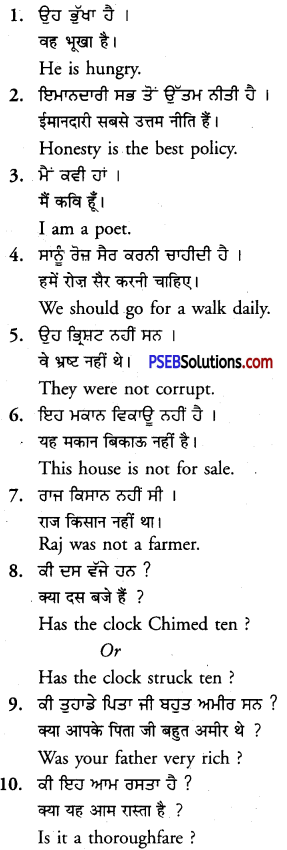

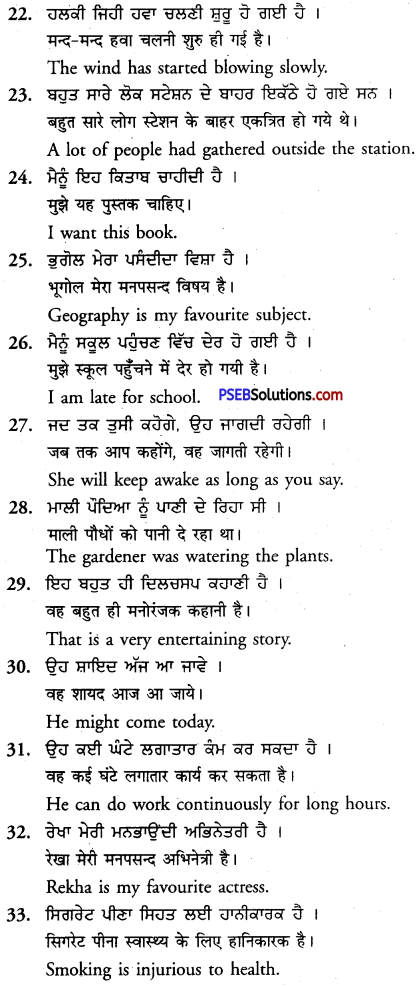
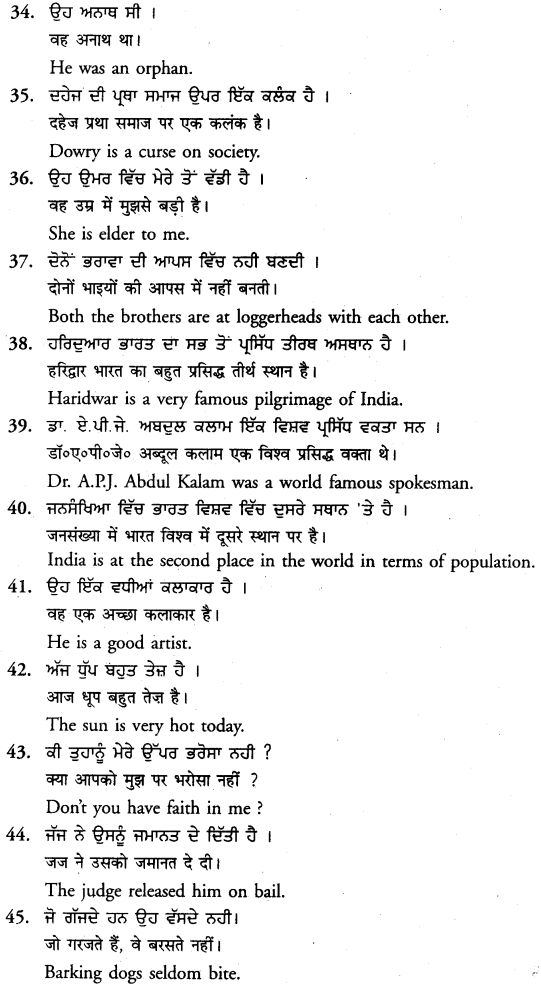
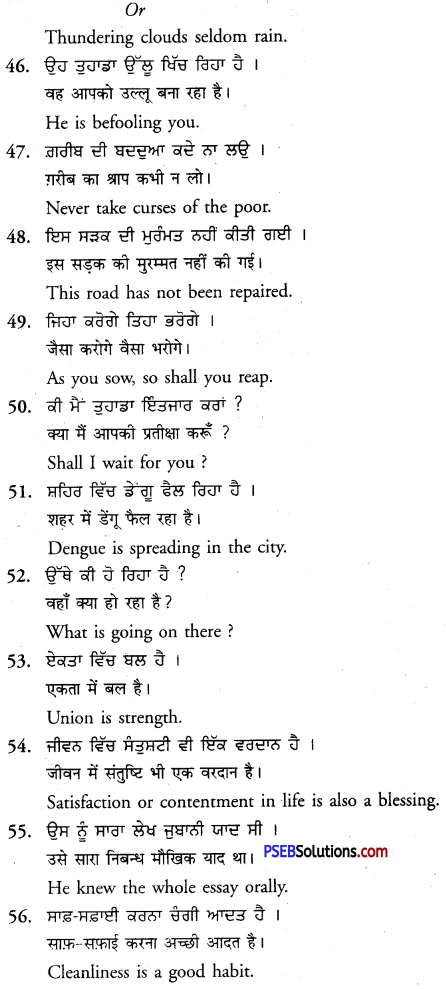
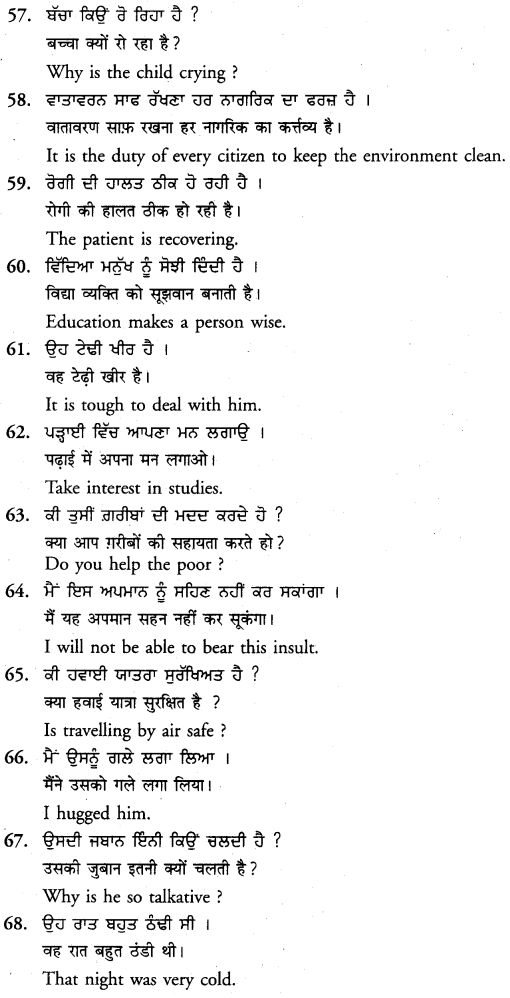
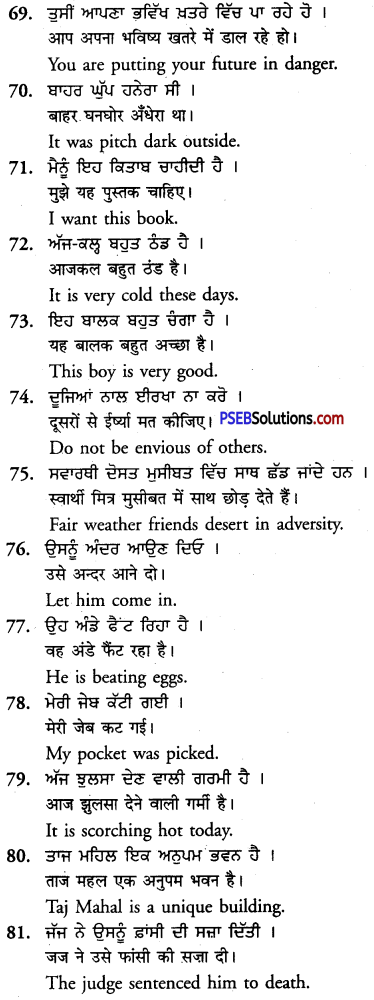
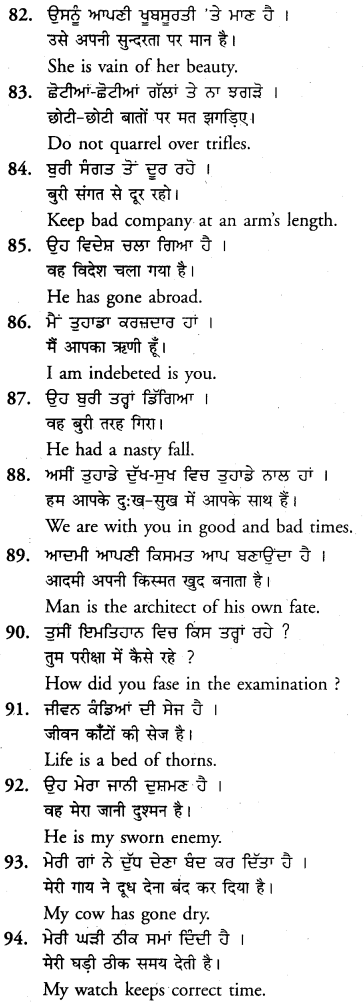
![]()
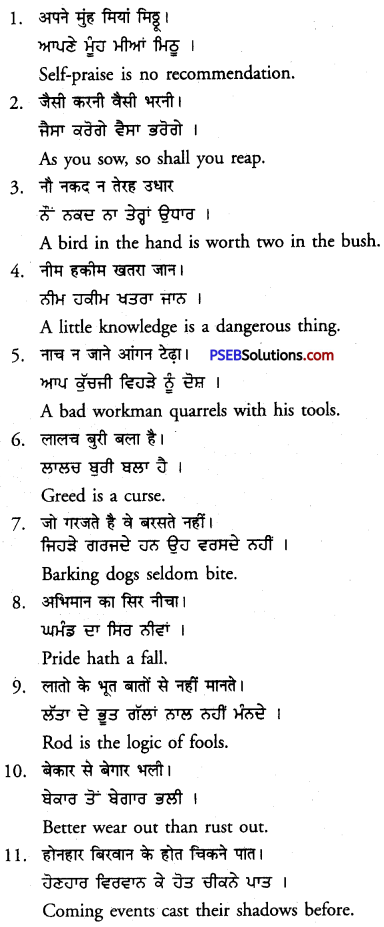
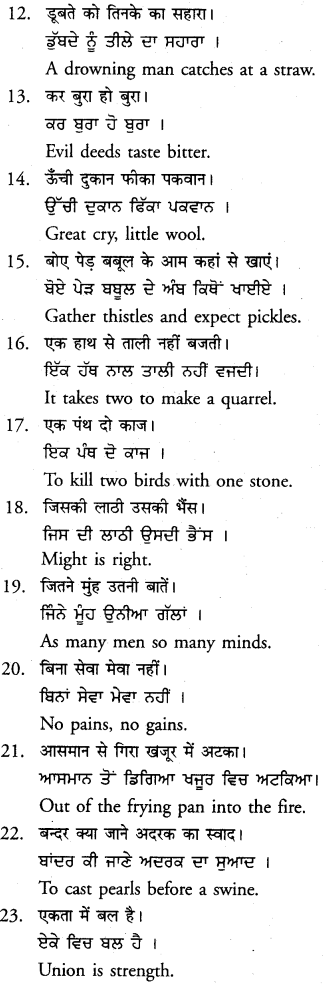
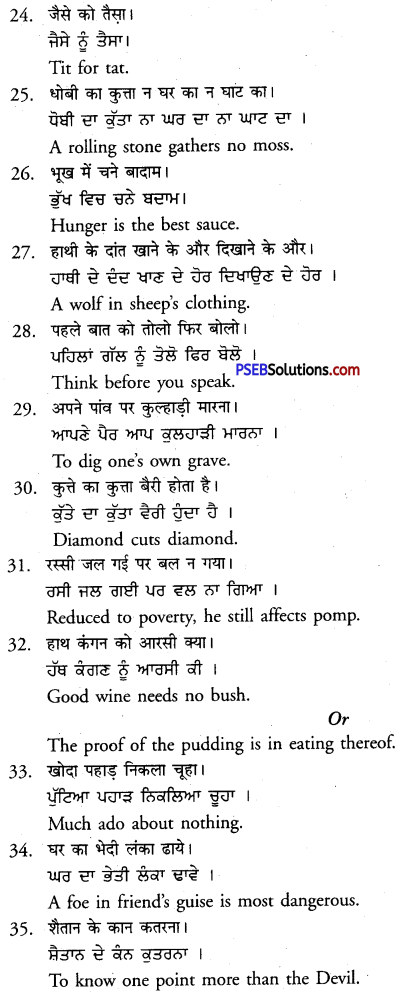
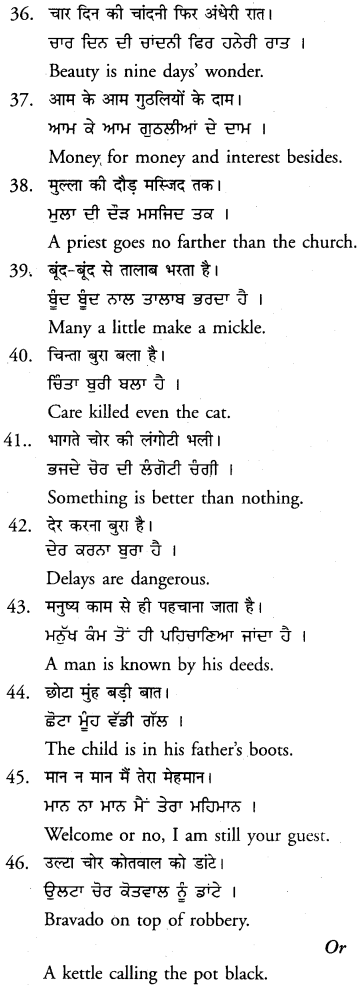
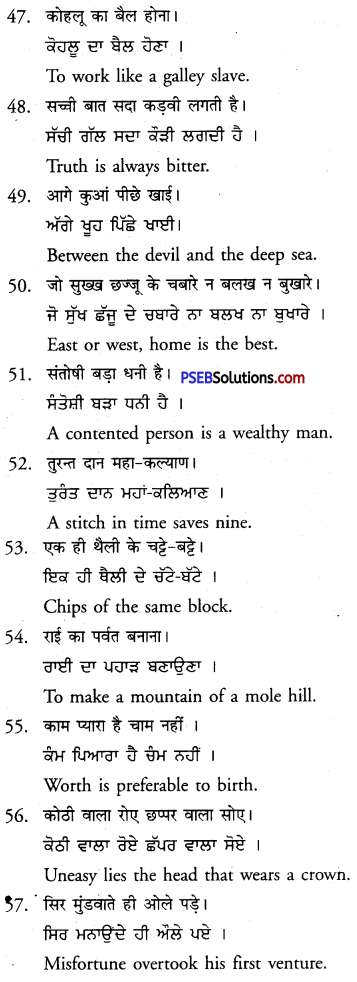
![]()
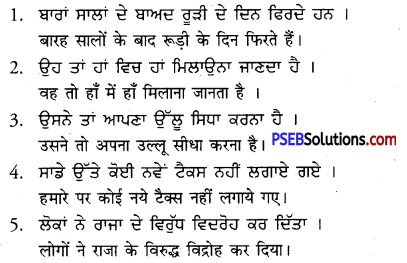
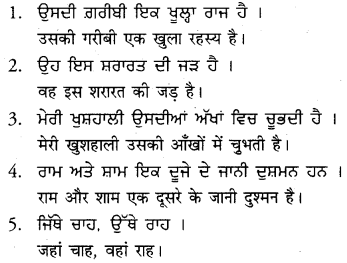


![]()



